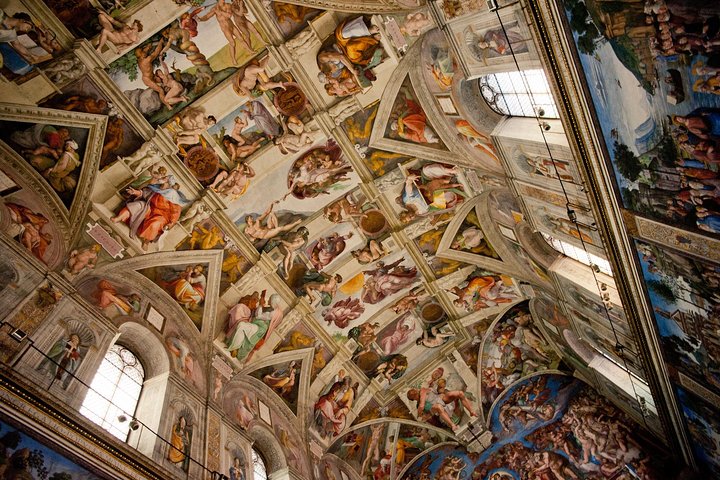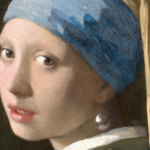Michelangelo’s “The Creation of Adam” stands as one of the most recognizable and influential works of art in human history. This monumental fresco, adorning the ceiling of the Sistine Chapel, captures a pivotal moment in the Biblical narrative of creation. The image of God reaching out to impart life to Adam has transcended its religious origins to become a universal symbol of the relationship between the divine and the mortal. This article delves deep into the multifaceted aspects of this masterpiece, exploring its artistic brilliance, philosophical implications, and enduring legacy in both Western culture and global consciousness.
The Artistic Genius of Michelangelo
Before delving into the intricacies of “The Creation of Adam,” it is crucial to understand the artistic genius behind this masterpiece. Michelangelo di Lodovico Buonarroti Simoni, known simply as Michelangelo, was a Renaissance art genius whose talents spanned sculpture, architecture, poetry, and painting. His work on the Sistine Chapel ceiling, including “The Creation of Adam,” represents a pinnacle of artistic achievement that continues to awe and inspire centuries later.
Michelangelo’s Unique Approach to Fresco Painting
Michelangelo’s approach to fresco painting was revolutionary for his time. Unlike many of his contemporaries who relied heavily on assistants, Michelangelo insisted on executing the majority of the work himself. This personal touch is evident in the nuanced details and emotional depth present in “The Creation of Adam.”
The artist’s technique involved applying wet plaster to small sections of the ceiling and then painting on this fresh surface before it dried. This method, known as buon fresco, required incredible speed and skill, as corrections were nearly impossible once the plaster set. Michelangelo’s mastery of this challenging technique allowed him to create figures with a sense of volume and movement that was unprecedented in fresco painting.
The Anatomical Precision in “The Creation of Adam”

One of the most striking aspects of “The Creation of Adam” is the anatomical accuracy of the figures. Michelangelo’s deep understanding of human anatomy, honed through years of studying cadavers, is on full display. The musculature of Adam, in particular, showcases the artist’s ability to render the human form with both scientific precision and artistic grace.
The pose of Adam, reclining on the earth with one arm extended, is a masterclass in foreshortening and perspective. This dynamic positioning creates a sense of tension and anticipation, drawing the viewer’s eye towards the focal point of the composition – the nearly touching fingers of God and Adam.
Color and Composition in the Fresco
While “The Creation of Adam” is often reproduced in isolation, it is important to consider its place within the larger context of the Sistine Chapel ceiling. Michelangelo’s use of color and composition ties this scene to the surrounding frescoes while also allowing it to stand out as a centerpiece.
The artist’s palette, dominated by warm flesh tones, soft earth hues, and the rich mauve of God’s robe, creates a visual harmony that enhances the spiritual theme of the work. The composition, with its clear division between the earthly and divine realms, establishes a visual dialogue that mirrors the theological concepts at play.
Symbolism and Interpretation
“The Creation of Adam” is rich in symbolism, inviting various interpretations that have been debated by art historians, theologians, and philosophers for centuries. The fresco’s deceptively simple composition belies a complex network of meanings and allusions.
The Divine Spark: Analyzing the Central Motif
The most iconic element of the fresco is undoubtedly the space between the fingers of God and Adam. This small gap has been interpreted as representing the spark of life, the moment of creation, and the connection between the divine and the human. The tension in this near-touch creates a sense of anticipation and energy that seems to pulse through the entire composition.
Some scholars have noted that the fingers of God and Adam form a line that divides the fresco diagonally, separating the earthly and heavenly realms. This division is further emphasized by the contrasting postures of the two central figures – God’s dynamic movement versus Adam’s languid repose.
The Representation of God and His Entourage
Michelangelo’s depiction of God in “The Creation of Adam” is notably unconventional for its time. Rather than the traditional portrayal of an elderly, bearded figure, Michelangelo presents God as a muscular, energetic being, surrounded by angels and wrapped in a swirling mantle.
This dynamic representation of the divine has led to various interpretations. Some see it as a reflection of Renaissance humanism, which sought to reconcile classical ideals with Christian theology. Others interpret the muscular God as a representation of divine power and creative force.
Adam: The Ideal Human Form
Adam, as depicted by Michelangelo, embodies the Renaissance ideal of human beauty and perfection. His pose, reminiscent of classical sculptures, emphasizes both his physical perfection and his spiritual potential. The slight sag in Adam’s body suggests that he is not yet fully animated, awaiting the divine touch to spring to life.
This representation of Adam as the archetypal human raises questions about the nature of humanity and our relationship to the divine. Michelangelo seems to suggest that humans, created in God’s image, have the potential for greatness but require divine inspiration to fully realize their capabilities.
Historical and Cultural Context

To fully appreciate “The Creation of Adam,” it is essential to understand the historical and cultural context in which it was created. The fresco is a product of the High Renaissance, a period of extraordinary artistic and intellectual ferment in Italy.
The Renaissance Worldview
The Renaissance marked a significant shift in European thought, characterized by a renewed interest in classical learning and a more humanistic outlook. This period saw a reevaluation of humanity’s place in the cosmos, with thinkers and artists exploring the relationship between the divine and the human in new ways.
Michelangelo’s work reflects this intellectual climate, blending Christian theology with classical aesthetics and humanist philosophy. “The Creation of Adam” can be seen as a visual representation of the Renaissance ideal of human potential and dignity, while still acknowledging the supremacy of divine power.
The Patronage of Pope Julius II
The creation of the Sistine Chapel frescoes was commissioned by Pope Julius II, a powerful and ambitious patron of the arts. Julius II’s vision for the papal court included grand artistic projects that would assert the power and prestige of the Catholic Church.
Michelangelo’s relationship with the Pope was often tumultuous, but the artist’s genius was undeniable. The commission of the Sistine Chapel ceiling allowed Michelangelo to showcase his talents on an unprecedented scale, resulting in one of the most significant artistic achievements of all time.
The Influence of Neoplatonism
The philosophical current of Neoplatonism, which sought to reconcile Platonic thought with Christian doctrine, was influential in Renaissance intellectual circles. This philosophy emphasized the idea of divine beauty manifesting in the physical world, a concept that resonates strongly in Michelangelo’s work.
In “The Creation of Adam,” we can see the influence of Neoplatonic ideas in the way Michelangelo portrays the human form as a reflection of divine perfection. The fresco can be interpreted as a visual exploration of the Neoplatonic concept of the human soul striving to reunite with its divine source.
The Legacy and Influence of “The Creation of Adam”

The impact of “The Creation of Adam” extends far beyond the realm of art history. This iconic image has become deeply embedded in Western cultural consciousness, influencing fields as diverse as literature, film, and popular culture.
Artistic Influence Through the Centuries
Michelangelo’s fresco has inspired countless artists across various mediums. From direct copies and reinterpretations in painting and sculpture to more subtle influences on composition and figural representation, the echoes of “The Creation of Adam” can be found throughout the history of Western art.
In the Baroque period, artists like Caravaggio and Rubens drew inspiration from Michelangelo’s dynamic compositions and muscular figures. Later, Romantic and Neoclassical artists would return to “The Creation of Adam” as a touchstone for depicting the sublime and the heroic.
“The Creation of Adam” in Popular Culture
The iconic image of the nearly touching hands has been appropriated and parodied in countless ways in popular culture. From advertisements to album covers, the composition has been adapted to comment on everything from technology to social issues.
This widespread use speaks to the universal appeal of the image and its ability to convey complex ideas in a visually striking and immediately recognizable form. The fresco’s central motif has become a shorthand for creation, connection, and the relationship between humanity and higher powers.
Scientific and Philosophical Interpretations
In recent decades, “The Creation of Adam” has been subject to intriguing scientific interpretations. Some researchers have suggested that the shape of God’s billowing cloak in the fresco resembles a cross-section of the human brain, proposing that Michelangelo may have been making a statement about the divine nature of human consciousness.
While such interpretations remain speculative, they demonstrate the ongoing relevance of the fresco as a subject of interdisciplinary study and debate. The work continues to inspire new readings and interpretations, bridging the gap between art, science, and philosophy.
Conclusion

“The Creation of Adam” stands as a testament to the enduring power of art to captivate, inspire, and provoke thought. Michelangelo’s masterpiece transcends its religious origins to speak to fundamental questions about human existence, creativity, and our relationship with the divine or the unknown.
As we continue to grapple with questions of origin, purpose, and the nature of consciousness, “The Creation of Adam” remains a powerful visual metaphor for the human condition. It reminds us of our potential for greatness while acknowledging the mysteries that lie beyond our grasp.
In the end, perhaps the true genius of Michelangelo’s work lies in its ability to spark endless contemplation and discussion. Like the space between the fingers of God and Adam, “The Creation of Adam” leaves room for interpretation, inviting each viewer to find their own meaning in its timeless imagery.
✉️ Stay Connected — Subscribe for Weekly Updates
Discover timeless stories, practical wisdom, and beautiful culture — delivered straight to your inbox.
*We only share valuable insights — no spam, ever.






